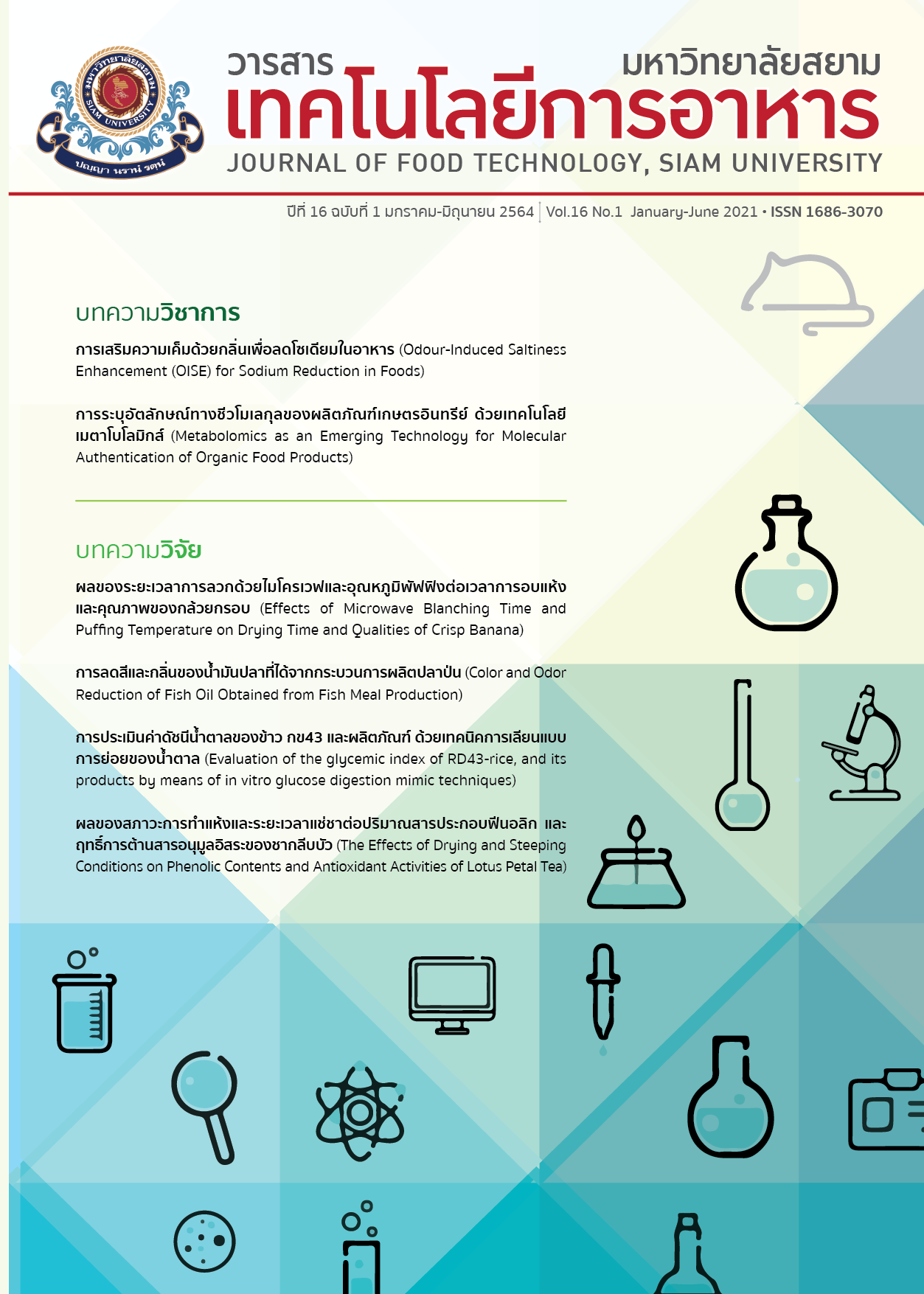The Effects of Drying and Steeping Conditions on Phenolic Contents and Antioxidant Activities of Lotus Petal Tea
Main Article Content
Abstract
This study investigated the effect of drying temperature and time, and steeping duration on moisture content, water activity (aw), total phenolic content and antioxidant activity using DPPH and ABTS assays of lotus petal tea. The lotus petal was dried at 50, 60, or 70 °C for 1-6 hours. Then, the dried petal was steeping in hot water (90 °C) for 3 or 5 min. The results showed that moisture content and aw of lotus petal decreased as increased drying time. The slope of drying curve of lotus petal that dried at 70 °C was higher than those of 50 and 60 °C. However, drying lotus petal at 70 °C presented lower total phenolic content and antioxidant activities than those dried at a lower temperature. The highest total phenolic content (16.18 mg/mL) was detected in the lotus petal tea prepared by dried at 50 °C and steeped for 5 min (p<0.05). The longer steeping duration significantly increased the amount of total phenolic and antioxidant activities of the lotus petal that dried at 50 and 60 °C (p<0.05). The optimum drying and steeping conditions were dried the lotus petal at 50 °C for 5 hours and steeped for 5 min.
Article Details
Copyrights of all articles in the Journal of Food Technology available in print or online are owned by Siam University and protected by law.
References
Zhao, C.N., Tang, G.Y., Cao, S.Y., Xu, X.Y., Gan, R.Y., Liu, Q., Mao, Q.Q., Shang, A. and Li, H.B. (2019). Phenolic profiles and antioxidantactivities of 30 tea infusions from green, black, oolong, white, yellow and dark teas. Antioxidants. 8(7): 215.
Chandrasekara, A. and Shahidi, F. (2018). Herbal beverages: Bioactive compounds and their role in disease risk reduction - A review. Journal of Traditional and Complementary Medicine. 8(4): 451–458.
Sivakumaran, K. and Amarakoon, S. (2018). Bioactivity of fruit teas and tisanes – A review. Journal of Pharmacognosy and Phytochemistry. 7: 323–327.
Limwachiranon, J., Huang, H., Shi, Z., Li, L. and Luo, Z. (2018). Lotus Flavonoids and phenolic acids: health promotion and safe consumption dosages. Comprehensive Reviews in Food Science and Food Safety. 17(2): 458–471.
Temviriyanukul, P., Sritalahareuthai, V., Promyos, N., Thangsiri, S., Pruesapan, K., Srinuanchai, W., Nuchuchua, O., Siriwan, D., On-nom, N. and Suttisansanee, U. (2020). The effect of sacred lotus (Nelumbo nucifera) and its mixtures on phenolic profiles, antioxidant activities, and inhibitions of the key enzymes relevant to Alzheimer’s disease. Molecules. 25 (3713): 2-18.
Temple, S.J., Temple, C.M., Van Boxtel, A.J.B. and Clifford, M.N. (2001). The effect of drying on black tea quality. The Journal of the Science of Food and Agriculture. 81(8): 764–772.
Ismanto, S.D., Rahmi, I.D. and Febrian, A. (2016). The influence of drying temperature on chemical components of herbal tea leaves (Spondias Dulcis, Soland). IOP Conference Series: Earth and Environmental Science. 583: 1-11.
Damiani, E., Bacchetti, T., Padella, L., Tiano, L. and Carloni, P. (2014). Antioxidant activity of different white teas: Comparison of hot and cold tea infusions. Journal of Food Composition and Analysis. 33(1): 59–66.
Castiglioni, S., Damiani, E., Astolfi, P. and Carloni, P. (2015). Influence of steeping conditions (time, temperature, and particle size) on antioxidant properties and sensory attributes of some white and green teas. International Journal of Food Science and Nutrition. 66(5): 491–497.
AOAC. (2000). Official Methods of Analysis. (15th ed.), Washington D.C., USA: Association of Analytical Chemists.
Pereira, V.P., Knor, F.J., Vellosa, J.C.R. and Beltrame, F.L. (2014). Determinação de compostos fenólicos e atividade antioxidante dos chás, verde, preto, e branco, de Camellia sinensis (L.) Kuntze, Theaceae. Revista Brasileira de Plantas Medicinais. 16(3): 490–498.
Xu, B.J. and Chang, S.K.C. (2007). A comparative study on phenolic profiles and antioxidant activities of legumes as affected by extraction solvents. Journal of Food Science. 72(2): 159–166.
Re, R., Pellegrini, N., Proteggente, A., Pannala, A., Yang, M. and Rice-Evans, C. (1999). Antioxidant activity applying an improved ABTS radical cation decolorization assay. Free Radical Biology and Medicine. 26(9–10): 1231–1237.
Ismanto, S.D., Anggraini, T. and Wahyu, B. (2017). The effect of drying temperature to chemical components of surian herbal tea leaves (Toona sureni, (Blume) Merr.). Research Journal of Pharmaceutical, Biological and Chemical Sciences. 8(229): 229–238.
Teshome, K., Debela, A. and Garedew, W. (2014). Effect of drying temperature and duration on biochemical composition and quality of black tea (Camellia sinensis L.) O. Kuntze at Wush Wush, south western Ethiopia. Asian Journal of Plant Sciences. 12(6): 235–240.
Hall N. (2000). Processing. Philadelphia: Elsevier.
Cheong, W.J., Park, M.H., Kang, G.W., Ko, J.H. and Seo, Y.J. (2005). Determination of catechin compounds in Korean green tea infusions under various extraction conditions by high performance liquid chromatography. Bulletin of the Korean Chemical Society. 26(5): 747–754.
Reblova, Z. (2012). Effect of temperature on the antioxidant activity of phenolic acids. Czech Journal of Food Sciences. 30: 171-177.
Fu, L., Xu, B.T., Gan, R.Y., Zhang, Y., Xu, X.R., Xia, E.Q. and Li, H.B. (2011). Total phenolic contents and antioxidant capacities of herbal and tea infusions. International Journal of Molecular Sciences. 12(4): 2112–2124.
Yang, J. and Liu, R.H. (2013). The phenolic profiles and antioxidant activity in different types of tea. International Journal of Food Science and Technology. 48(1): 163–171.
Zheng, M., Xia, Q. and Lu, S. (2015). Study on drying methods and their influences on effective components of loquat flower tea. LWT - Food Science and Technology. 63:14-20.
Gan, R.U., Lui, W.Y., Chan, C.L. and Corke, H. (2017). Hot air drying induces browning and enhances phenolic content and antioxidant capacity in mung bean (Vigna Radiata L.) sprouts. Journal of Food Processing and Preservation. 41(1): e12846.


